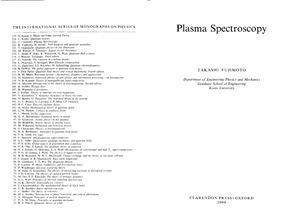Clarendon Press, Oxford, 2004, 287 p.
Throughout the history of spectroscopy, plasmas have been the source of radiation, and they were studied for the purpose of spectrochemical analysis and also for the investigation of the structure of atoms (molecules) and ions constituting, these plasmas. About a century ago, the spectroscopic investigations of the radiation emitted from plasmas contributed to establishing quantum mechanics. However, the plasma itself has been the subject of spectroscopy to a lesser extent. This less-developed state of plasma spectroscopy is attributed partly to the complicated relationships between the state of the plasma and the spectral characteristics of the radiation it emits. If we are conceed with the intensity distribution of spectral lines over a spectrum, we have to understand the population density distribution over the excited levels of atoms and ions in the plasma. Since the latter distribution is goveed by a collection of an enormous number of atomic processes, e.g. electron impact excitation, deexcitation. ionization, recombination, and radiative transitions, and since the spatial transport of the plasma panicles and the temporal development are sometimes essential as well, it is rather difficult, by starling from these elementary processes, to deduce a straightforward consequence conceing the population distribution, For certain limiting conditions of the plasma, e.g. for the low- or high-density limit, several concepts like corona equlibrium and local thermodynamic equlibrium have been proposed, but they have been accepted on a rather intuitive basis.
This book is intended first to provide a theoretical framework in which we can treat various features of the population density distribution over the excited levels (and the ground state) of atoms and ions and give their interpretation in a unified and coherent way. In this new framework several concepts, some of which are already known and some newly derived, are properly defined. For these purposes, we take hydrogen-like ions (and neutral hydrogen) as an example of an ensemble of atoms and ions immersed in a plasma, hollowing the first three introductory chapters, these problems are discussed in the subsequent two chapters. The following three chapters are devoted to several facets which are useful in performing a spectroscopy experiment. This volume concludes with a chapter treating several phenomena characteristic of dense plasmas. This chapter may be regarded as an application of the theoretical methods developed in the first part of the volume.
The main body of this book is based on my half-year course given at the Graduate School. Kyoto University, for more than a decade. This book is intended mainly for graduate students, but it should also be useful for researchers working in this field. A reader who wants to obtain only the basic ideas may skip the chapters and sections marked with an asterisk.
Contents
Introduction
Thermodynamic equilibrium
Atomic processes
Population distribution and population kinetic
Ionization and recombination of plasma
Continuum radiation
Broadening of spectral lines
Radiation transport
Dense plasma
Throughout the history of spectroscopy, plasmas have been the source of radiation, and they were studied for the purpose of spectrochemical analysis and also for the investigation of the structure of atoms (molecules) and ions constituting, these plasmas. About a century ago, the spectroscopic investigations of the radiation emitted from plasmas contributed to establishing quantum mechanics. However, the plasma itself has been the subject of spectroscopy to a lesser extent. This less-developed state of plasma spectroscopy is attributed partly to the complicated relationships between the state of the plasma and the spectral characteristics of the radiation it emits. If we are conceed with the intensity distribution of spectral lines over a spectrum, we have to understand the population density distribution over the excited levels of atoms and ions in the plasma. Since the latter distribution is goveed by a collection of an enormous number of atomic processes, e.g. electron impact excitation, deexcitation. ionization, recombination, and radiative transitions, and since the spatial transport of the plasma panicles and the temporal development are sometimes essential as well, it is rather difficult, by starling from these elementary processes, to deduce a straightforward consequence conceing the population distribution, For certain limiting conditions of the plasma, e.g. for the low- or high-density limit, several concepts like corona equlibrium and local thermodynamic equlibrium have been proposed, but they have been accepted on a rather intuitive basis.
This book is intended first to provide a theoretical framework in which we can treat various features of the population density distribution over the excited levels (and the ground state) of atoms and ions and give their interpretation in a unified and coherent way. In this new framework several concepts, some of which are already known and some newly derived, are properly defined. For these purposes, we take hydrogen-like ions (and neutral hydrogen) as an example of an ensemble of atoms and ions immersed in a plasma, hollowing the first three introductory chapters, these problems are discussed in the subsequent two chapters. The following three chapters are devoted to several facets which are useful in performing a spectroscopy experiment. This volume concludes with a chapter treating several phenomena characteristic of dense plasmas. This chapter may be regarded as an application of the theoretical methods developed in the first part of the volume.
The main body of this book is based on my half-year course given at the Graduate School. Kyoto University, for more than a decade. This book is intended mainly for graduate students, but it should also be useful for researchers working in this field. A reader who wants to obtain only the basic ideas may skip the chapters and sections marked with an asterisk.
Contents
Introduction
Thermodynamic equilibrium
Atomic processes
Population distribution and population kinetic
Ionization and recombination of plasma
Continuum radiation
Broadening of spectral lines
Radiation transport
Dense plasma

